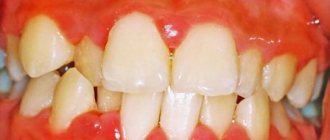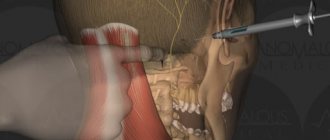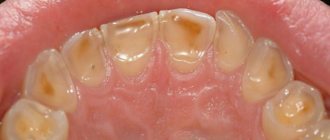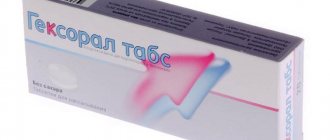What it is
This type of stomatitis is provoked by enteroviruses entering the body. The very concept of “enterovirus” unites a large number of viral infections that actively multiply in the human gastrointestinal tract when they enter it with water, with agricultural products or from animal carriers. The virus can also be transmitted through blood-sucking insects, entering directly into the blood and ultimately leading to the development of vesicular stomatitis.
Due to their increased resistance to high acidity, detergents and even chlorine in running water, enteroviruses can survive in unboiled milk and cold-leavened dairy products, on the surface of vegetables, fruits and herbs for up to three to four months. The only way to combat them is heat treatment at a temperature of at least fifty degrees.
Enteroviral stomatitis does not occur in all people who become ill under the influence of this group of viruses, however, the occurrence of vesicular inflammation during enterovirus infection is far from uncommon, especially if there are microdamages to the mucous membrane in the oral cavity.
Types of enteroviruses
There are more than 100 causative agents of this infection. The main ones are ECHO, polioviruses (the causative agents of polio), Coxsackie viruses A and B, and enteroviruses that cannot be classified.
Coxsackie viruses are several serotypes of the pathogen belonging to groups A, B and C. Coxsackie viruses type A are the cause of severe forms of enteroviral diseases. These are hemorrhagic conjunctivitis, herpetic sore throat, aseptic meningitis. Type B is more dangerous because it provokes hepatitis, myocarditis, and pericarditis. Source: V.V. Botvinyeva, L.S. Namazova-Baranova, O.B. Gordeeva, O.K. Botvinyev, T.N. Konopleva Modern possibilities for diagnosis, prevention and treatment of Coxsackie enterovirus infection in children // Pediatric pharmacology, article received: 01/22/2012, accepted for publication: 05/12/2012.
ECHO viruses are most dangerous for newborns. In them they cause meningitis, myocarditis, and hepatitis. This often causes death. There are no complications in older children.
Causes
Enteroviruses themselves exist everywhere, and it is impossible for humans to avoid encountering them. However, these viruses do not provoke disease in all people, much less the formation of vesicular stomatitis. The most important prerequisite for its onset is a reduced level of the body’s resistance to infections due to weakened immunity.
Main methods of infection:
- airborne droplets (when talking to a carrier, sneezing, coughing);
- contact (through common objects);
- fecal-oral (when the virus gets from manure used for fertilizer onto vegetables, herbs and fruits).
The main viral agents that can be called vesicular stomatitis viruses are enterovirus 71 and Coxsackie viruses.
The risk of the disease in adults is very small; children in the first two to three years of life mainly suffer from this complication of enterovirus infection. Peaks of incidence occur in autumn and spring, and in warmer countries the risk of getting sick increases from mid-summer, since with high air temperatures and high humidity, the lifespan of the virus outside the host’s body increases greatly.
Enterovirus infection in children and adults: signs, treatment
14.06.2017
Enterovirus infection in children and adults: signs, treatment
Acute infectious diseases caused by intestinal viruses belong to the group of enteroviral infections.
The pathology affects various human organs and is manifested by fever and a wide range of clinical signs. Enterovirus infection is characterized by outbreaks of mass diseases, especially in children's organized groups and families. The risk group includes people with reduced immunity - children, the elderly, people with chronic pathologies. Enterovirus infection is characterized by high susceptibility of the population and seasonality - an increase in incidence in the summer-autumn season. A feature of enteroviruses is the ability to cause clinical symptoms of varying intensity: from mild discomfort to the development of paralysis and paresis.
Etiology
The causative agents of enterovirus infection are RNA-containing Coxsackie viruses, ECHO viruses, and polioviruses. Microbes have relatively high resistance to physical factors - cooling and heating, as well as some disinfectants. Prolonged boiling, disinfectants with chlorine, formaldehyde and ultraviolet radiation have a detrimental effect on viruses.
Enteroviruses remain viable in the external environment for quite a long time. High air temperatures and high humidity increase the lifespan of the virus.
Sources of infection are patients and virus carriers.
Infection occurs through:
- Dirty hands, water, vegetables and fruits
- When talking, coughing, sneezing.
- When the pathogen is transmitted from a sick mother to the fetus.
Microbes multiply on the mucous membrane of the pharynx and accumulate in nasopharyngeal discharge, feces, and cerebrospinal fluid.
During the incubation period, the virus is released into the environment in small quantities. Patients remain dangerous to others for a month, and in some cases longer. Microbes enter the mucous membrane of the esophagus and upper respiratory tract, multiply and cause local inflammation, which occurs in the form of respiratory disease, pharyngitis, sore throat and intestinal upset. The period of reproduction and accumulation of viruses coincides with incubation and ranges from one to three days. Pathogenic biological agents enter the cervical and submandibular lymph nodes. At this time, patients develop pharyngitis and diarrhea. With the blood flow, microbes spread throughout the body, affecting internal organs with the development of another pathology and the appearance of corresponding symptoms.
Symptoms
Enterovirus infection often occurs without any characteristic symptoms and resembles a common cold. Viruses, affecting various organs and systems, usually cause herpangina, hemorrhagic inflammation of the conjunctiva, fever, gastroenteritis, and in rare cases, severe diseases: inflammation of the brain, liver, myocardium.
Symptoms of enterovirus infection:
Increased body temperature, feeling hot Thirst, dry mouth, weakness. The appearance of a characteristic rash Inflammation of the respiratory system, redness and inflammation of the oral mucosa. Frequent loose stools, abdominal pain.
Persons with strong immunity and a relatively healthy body rarely suffer from severe enteroviral diseases. Their infection is usually asymptomatic. Newborns, small children, elderly people and those weakened by chronic diseases are more susceptible to the development of enteroviral meningoencephalitis, hepatitis, myocarditis, and paralysis. Herpetic tonsillitis, acute respiratory infections and pharyngitis are less severe, but are accompanied by a persistent, painful cough.
Herpangina is one of the most frequently occurring forms of enterovirus infection. Its causative agents are Coxsackie viruses. The disease manifests itself with symptoms of intoxication and catarrhal syndromes.
Herpetic (herpetic) sore throat
Herpangina begins acutely. The body temperature of patients rises to 40 degrees, nausea, malaise, and headache occur.
Around the second day, signs of catarrhal inflammation of the pharynx appear.
After a couple of days, papules form on the tonsils, arches, tongue and palate, which eventually turn into red blisters. They burst, forming erosions on the mucous membrane, covered with plaque, which resolve without a trace in 5 days.
Lymph nodes are slightly enlarged.
Sore throat with herpangina is often absent or appears only during the formation of erosions.
acute respiratory infections
The respiratory form of enterovirus infection is manifested by symptoms similar to ARVI of any other etiology. Patients complain of fever, sore throat, hoarseness, dry cough, runny nose and nasal congestion. Usually these signs are combined with symptoms of indigestion.
The temperature remains high for 4-5 days and then gradually decreases. Other signs of the disease remain for another 2-3 weeks.
The catarrhal form is more common than others and occurs as pharyngitis, laryngitis, rhinitis or combined pathology. In young children, a symptom occurs that requires special attention. This is a barking, dry cough that makes it difficult for a child to breathe, especially at night. Attacks of “false croup” pose a great danger to children's health.
The cold-like form of enterovirus infection usually does not last long and is rarely accompanied by complications.
Enteroviral exanthema
In patients with enterovirus infection, from about 2-3 days of pathology, a rash appears on the skin in the form of pink spots and papules, often with hemorrhages. For two to three days, the rash remains on the body, and then gradually disappears without a trace. Exanthema is often combined with herpangina, stomatitis and meningitis.
Rare clinical manifestations of enterovirus infection:
Anicteric hepatitis, Meningoencephalitis, Inflammation of the optic nerve, Inflammation of the myocardium and pericardium, Lymphadenitis, Nephritis, Paralysis and paresis.
Complications
Inflammation of the brain and peripheral nerves are the most common and dangerous complications of enterovirus infection.
Patients who consult a doctor late and have a severe form of pathology may develop life-threatening diseases - cerebral edema, respiratory and cardiac arrest.
In young children, ARVI of enteroviral etiology is often complicated by the development of “false croup,” and in adults, by secondary bacterial infection with the development of bronchopneumonia.
Features of pathology in children
Enterovirus infection in children occurs in the form of sporadic diseases, but more often in the form of epidemic outbreaks in organized children's groups. The incidence increases in the warm season. For children of preschool and primary school age, the fecal-oral mechanism of transmission of the pathogen is characteristic.
Enterovirus infection in children usually occurs in the form of sore throat, serous inflammation of the meninges, and paralysis.
The pathology clinic is developing rapidly. The temperature rises sharply, chills, dizziness and headache appear, sleep and appetite are disturbed. Against the background of severe intoxication, characteristic signs begin to appear - tonsillitis, catarrhal inflammation of the nasopharynx, myalgia, stool disorder, enteroviral exanthema.
Enteroviral stomatitis
Enteroviral stomatitis develops in children aged 1-2 years after enteroviruses enter the body.
Symptoms of the disease are:
- Pain when swallowing
- Increased salivation
- Low-grade fever,
- Arthralgia and myalgia,
- Runny nose,
- Sore throat,
- Chills,
- Malaise,
- Swelling of soft tissues in the mouth.
The child becomes lethargic, restless, and capricious.
Typical vesicles with a characteristic red rim appear on the skin and mucous membranes. The rashes hurt and itch. These symptoms intensify with the appearance of new lesions. The disease develops quickly: blisters appear on the third day of infection, and on the seventh day the patient recovers.
Typically, enteroviral stomatitis is combined with exanthema, gastroenteritis, fever, and sore throat. In more rare cases, stomatitis is asymptomatic.
Diagnostics
Diagnosis of enterovirus infection is based on characteristic clinical symptoms, patient examination data, epidemiological history and laboratory test results.
Material for research - a swab from the throat, discharge from oral ulcers, feces, cerebrospinal fluid, blood.
Virological testing is the main diagnostic method. To detect enteroviruses, the following are used: PCR, serodiagnosis, molecular biological method, immunohistochemistry.
All of these methods are rarely used in mass examination of patients, since they are lengthy, complex and do not have high diagnostic value, which is associated with a large number of asymptomatic carriers of enteroviruses.
Treatment is prescribed by a doctor!
Treatment of enterovirus infection includes:
- Compliance with the regime
- Balanced and rational nutrition,
- Taking multivitamins,
- Etiotropic and pathogenetic therapy.
Regimen and diet
Mild and moderate forms of pathology are treated at home with strict bed rest. Patients with severe forms, prolonged fever and complications are hospitalized.
Patients are prescribed a diet that reduces intoxication, increases immunity, and spares the digestive organs. The patient's diet should contain sufficient amounts of protein, vitamins, and minerals. Drinking plenty of fluids is recommended to detoxify the sick body.
Pregnant women and children should be under the supervision of a specialist throughout the entire illness. Only a doctor, after making a diagnosis, should prescribe medications and their dosages allowed for a certain period of pregnancy and age group.
Self-medication of enterovirus infection is strictly prohibited. This is due to the nonspecificity of the symptoms of the disease, the possibility of confusing the pathology and being treated incorrectly.
Prevention
Specific prevention for enterovirus infection has not been developed.
Main events:
- Isolation of the patient
- Disinfection of the premises,
- Regular ventilation
- Compliance with hygiene standards and rules,
- Observation of contacts for 2 weeks,
- Use of Grippferon or Interferon drops for prophylactic purposes,
- Conducting hygiene education for children and adolescents,
- Maintaining personal hygiene rules
- Avoid hypothermia and drafts,
- Take vitamin complexes twice a year,
- Handle food correctly
Symptoms
Most often, the disease caused by enteroviruses is asymptomatic, but some patients (up to three percent of all infected) experience serious complications. The most common of them is enteroviral vesicular stomatitis with exanthema, i.e. rashes (grayish-white vesicles) localized on the palms, soles and mouth (on the inner surface of the cheeks, on the lips, tongue and even in the throat). It is thanks to this localization of the rash that vesicular stomatitis with exanthema received another name, often used among the people - “arm, leg, mouth” syndrome.
In addition to the characteristic rash with severe itching, increased salivation and pain when swallowing, this disease may be accompanied by increased body temperature and fever, weakness, chills, muscle pain, hyperemia and swelling of the soft tissues of the oral cavity, headaches and pain in the gastrointestinal tract, nausea, vomiting or diarrhea, runny nose and sore throat, and photophobia.
Since rashes appear later than other symptoms, clinic doctors often make the wrong diagnosis: acute respiratory infections, acute respiratory viral infections, allergies, dermatitis, rotavirus infection, herpes, and even simple teething. Accordingly, medications are prescribed that eliminate some of the symptoms, but blur the picture of the underlying disease.
In fact, with a fairly mild course of the disease, no specific treatment for enteroviral vesicular stomatitis is required. The first signs appear five to six days after infection, blisters appear around the third day, and after seven to ten days the patient fully recovers.
The incubation period for this infection can vary from a couple of days to a week. In the initial stages of the disease, the infectiousness of the infected person is much higher than in recent days, however, the elimination of enterovirus in feces can continue for up to a month after the onset of the disease.
Vesicular stomatitis: before and after photos
The disease vesicular stomatitis mainly occurs in the summer, when insects become more active. 2-6 days after the virus enters the body, a person begins to feel a headache and chills, he has a fever, enlarged cervical lymph nodes, a runny nose, and ulcers affect the lips, gums, inner surfaces of the cheeks and tongue. Rashes with vesicular stomatitis are quite painful, so eating causes severe discomfort.
How to treat
Since a sick child is contagious to the entire group of children (adults are least susceptible to the disease), the first step is to isolate him from other children. If you find rashes on the oral mucosa, you need to contact your dentist, who will tell you how to treat vesicular stomatitis.
Most often, no specific treatment is prescribed. In case of increased pain, the child may be prescribed painkillers, local applications and rinses. Antiviral drugs and vitamin-mineral complexes may also be prescribed to support immunity. During the period of illness, it is necessary to carefully observe hygiene, be sure to wash your hands with soap after visiting the toilet and before eating.
Treatment of vesicular stomatitis
When treating vesicular stomatitis, symptomatic therapy is prescribed, including:
- drinking plenty of water;
- complete rest;
- treatment of the oral mucosa with antiseptic solutions;
- taking antipyretic drugs;
- the use of antiviral ointments (oxolinic, redoxol, tebrofen).
As a rule, vesicular stomatitis does not cause complications, and signs of the disease quickly go away if the patient strictly follows the doctor’s instructions.
A childhood viral disease is also treated quite quickly and goes away without a trace if you see a dentist on time. As a medicine, the doctor may recommend taking an immunomodulator, which will help cope with the disease and will be an excellent prophylactic for the prevention of other viral diseases.
Treatment of vesicular stomatitis of the enteroviral type is generally carried out in the same ways as usual, that is, it is symptomatic. The disease cannot be neglected, as there is a risk of developing such serious complications as meningitis, encephalitis and acute flaccid paresis.
Another important point in the treatment of vesicular stomatitis in children is the isolation of children from the group so that the disease is not transmitted to others. And do not forget that hygiene items (in particular, a towel) must be individual.
Diagnostic methods
Diagnosis in most cases can be made by characteristic symptoms, physical examination, and medical history.
After examining and collecting complaints, the pediatrician will prescribe a series of tests aimed at identifying the type of virus. The doctor may prescribe:
- general urine analysis;
- stool analysis;
- blood tests (general, biochemical, serological, etc.);
- immunohistochemical analysis of tissues (to detect antibodies to enterovirus infection);
- cultures of biomaterial (saliva, throat scrapings, etc.).
An accurate diagnosis may also require a differential diagnosis to exclude other diseases with a similar clinical picture.
Other diagnostic tests are also performed:
- Laboratory Serology is a blood test that detects an increased amount of antibodies. The body produces them to fight the virus in the acute period and during the recovery stage. The analysis allows you to determine ECHO 6, 7, 9, 11, 30 and Coxsackie B1-B6. A negative result does not necessarily mean that you do not have the disease; it just does not detect other types of viruses. PCR is a highly sensitive (100%) and specific (97%) test. Allows the detection of enterovirus RNA in the cerebrospinal fluid. Blood PCR detects the virus in 30% of patients with chronic fatigue syndrome. Source: A.V. Demina, V.A. TERNOVOY, N.I. Shulgina, S.V. Netesov Enteroviruses. Part 3. Laboratory diagnostics, treatment, immunoprophylaxis // Bulletin of the Siberian Branch of the Russian Academy of Medical Sciences, volume 31, No. 3, 2011. An analysis of cerebrospinal fluid is needed if there are symptoms of damage to the spinal cord, brain and their membranes. The fluid is collected by puncturing. With aseptic meningitis, the level of leukocytes is increased. Glucose is normal or slightly reduced. Protein is normal or slightly increased. Troponin I and cardiac enzymes is a blood test to determine the level of these indicators. If they are elevated, it means the heart is damaged. Normally, the serum troponin I level should be from 0 to 0.5 ng/ml. RT-PCR is an analysis to detect common regions of enterovirus RNA. The test has a sensitivity of 95% and specificity of 97%. Approved for the diagnosis of enteroviral meningitis. The best results are obtained if the material for research is cerebrospinal fluid. Sputum, blood and mucus from the respiratory tract, and feces can be examined. However, the result will not be as accurate.
- Instrumental Electroencephalography – assesses the degree and severity of the disease. Chest X-ray - may reveal an increase in cardiac volume in patients with myopericarditis. Echocardiography – performed if myocarditis is suspected. Shows abnormal movement of the walls of the heart chambers. May reveal acute reduction in ejection fraction and ventricular dilatation in severe cases. Examination by an ophthalmologist using a slit lamp is indicated for those children who have hemorrhagic conjunctivitis and corneal erosions. Coxsackie A24 and Enterovirus 70 viruses can be detected from conjunctival smears within 3 days of infection.
Prevention
The basis for the prevention of enterovirus infection in a child is compliance with the rules of hygiene:
- washing hands and food before consumption;
- boiling water;
- avoiding places where large numbers of people gather during an epidemic.
- It is extremely important to take measures to increase immunity: follow a routine, eat right, and harden yourself.
In the pediatric medical department, all conditions have been created for the diagnosis and treatment of enterovirus infection in a child. For seriously ill patients, the department operates a 24-hour hospital, where the small patient will be under the constant supervision of qualified medical personnel and doctors. Remember that the sooner the correct diagnosis is made and the type of virus is determined, the easier it will be to cure the child and avoid complications.
Sources:
- G.P. Martynov. Enterovirus (non-polio) infection in children // Siberian Medical Review, 2014.
- V.V. Botvinyeva, L.S. Namazova-Baranova, O.B. Gordeeva, O.K. Botvinyev, T.N. Konopleva. Modern possibilities for diagnosis, prevention and treatment of Coxsackie enterovirus infection in children // Pediatric pharmacology, article received: 01/22/2012, accepted for publication: 05/12/2012.
- A.V. Demina, V.A. Ternova, N.I. Shulgina, S.V. Netesov. Enteroviruses. Part 3. Laboratory diagnostics, treatment, immunoprophylaxis // Bulletin of the Siberian Branch of the Russian Academy of Medical Sciences, volume 31, No. 3, 2011.
Markova Daria Olegovna Clinic
Author of the article
Markova Daria Olegovna
Specialty: pediatrician
Experience: 15 years
The information in this article is provided for reference purposes and does not replace advice from a qualified professional. Don't self-medicate! At the first signs of illness, you should consult a doctor.








